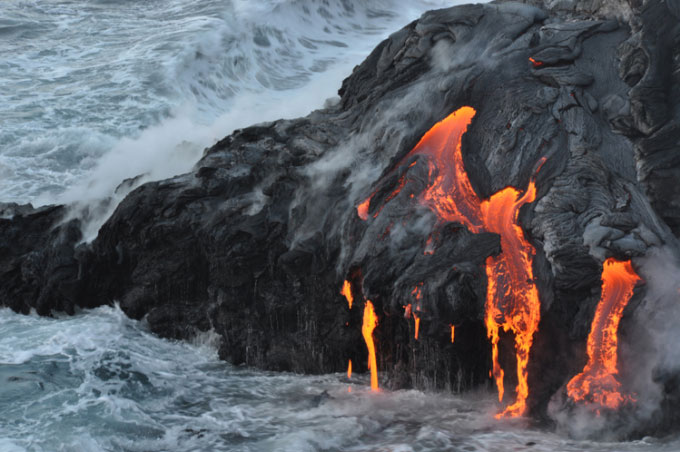Robot captures 320,000m2 lava field under the sea
Lava erupting from a volcano on the island of La Palma flows into the Atlantic Ocean, creating a new structure, captured by robots and 360-degree cameras.
Researchers at Las Palmas University's Institute of Global Change and Oceanography used robots and 360-degree cameras to capture lava fields 20 meters below sea level , Newsweek reported on October 14. This structure was formed by lava spewing from the Cumbre Vieja volcano on the island of La Palma, Canary Islands, Spain.
The lava field has now stopped developing with an area of about 320,000m 2 . The Canary Islands Volcanic Risk Special Protection Team (Pevolca) team will use this video to learn more about how lava plains form.
Lava plains form when lava reaches the ocean or other large body of water. The contact causes the lava to cool, while the water boils and produces steam. If the lava flow continues, eventually the lava band will appear. The most striking example of land created in this way is the Hawaiian Islands.

Lava flows into the Pacific Ocean at Kupapa'u Point, Kilauea, Hawaii. (Photo: USGS)
In fact, the Big Island of Hawaii is still expanding due to this phenomenon. Here, lava from Kilauea volcano flows down into the Pacific Ocean, forming an unstable lava band. When solid, it will become additional land for the island.
The Cumbre Vieja volcano began erupting on September 19 with a new crack opening on September 24. Since the eruptions began three weeks ago, about 6,700 people have been evacuated. The lava destroyed about 1,000 buildings, ravaging villages and farmland.
Lava flowed into the Atlantic Ocean at an estimated speed of 0.8 km/h on October 7. This creates plumes of smoke that experts warn could lead to skin and breathing problems for La Palma residents. In addition to steam, contact between lava and water also produces lava (laser) haze, which is highly acidic and may contain chlorine.
This mixture has the stinging and corrosive properties of the dilute acid in the battery and should be avoided. The laser can be carried by the wind, so its corrosive effects extend much further than where lava flows into the sea, according to the US Geological Survey (USGS).
- Detecting giant lava tubes, can cause polarity to reverse the Earth's magnetic field
- 1500 years from now Earth's magnetic field may be reversed
- Hot lava rivers like the Sun flow from Canada to Russia
- What is lava?
- Robot revolution in the field of medicine
- Active plastic silicone robot without batteries
- Robots do not need batteries, no wires are still running well
- Process of collecting molten lava from volcanoes
- Video: What happens when lava meets ice?
- Detected many strange lava columns on Mars
- Why does lava melt in the Earth's heart without causing the Earth's crust to melt?
- South Korea develops mannequin robot
 Surprised: Fish that live in the dark ocean still see colors
Surprised: Fish that live in the dark ocean still see colors Japan suddenly caught the creature that caused the earthquake in the legend
Japan suddenly caught the creature that caused the earthquake in the legend A series of gray whale carcasses washed ashore on California's coast
A series of gray whale carcasses washed ashore on California's coast Compare the size of shark species in the world
Compare the size of shark species in the world